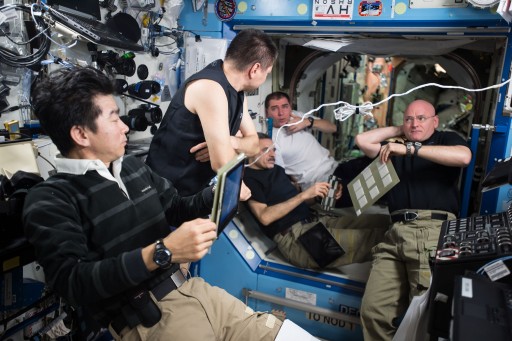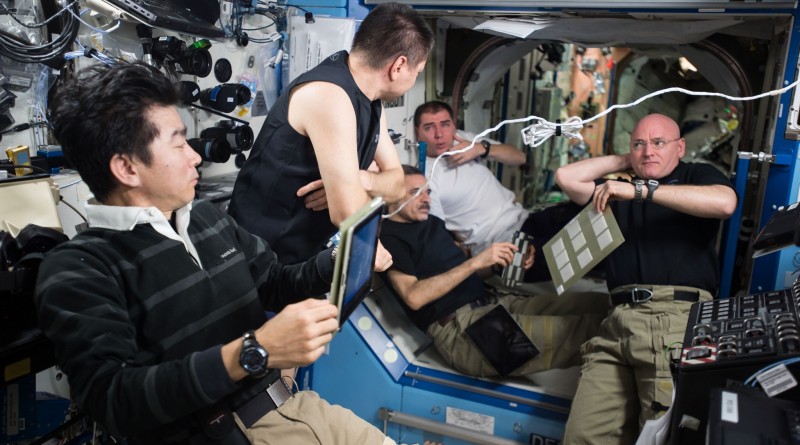ISS Operations Update – October 30, 2015

Experiments:
Pilot-T [This experiment puts crew members through complex tasks, such as piloting a space vehicle, at various stages of a long-duration mission to assess crew member performance reliability over long mission durations.]
Proboy Experiment [This experiment uses a suite of acoustic instruments feeding a standalone recorder and signal processor to evalaute an acoustic system for quickly locating acoustic pulse sources such as punctures of the hull of the spacecraft. A pulse source is used to simulate the acoustic signature of impacts of high-speed particles that can puncture the shell of the Station’s modules.]
Plasma Kristall-4 [The PK-4 payload set up in the Columbus European Physiology Module Rack and examines low temperature gas mixtures comprised of ionized gases, neutral gas and micron-scale particles. The micro-patricles become charged in the plasma and undergo interactions with each other leading to a self-organized structure known as plasma crystals.]
Otklik Experiment Hardware Check [Otklik uses several piezoelectric sensors to track the impacts of small particles and debris on the exterior of the International Space Station to monitor the abundance of debris events and a series of other characteristics. These measurements provide valuable data for the construction of future spacecraft]
Plant Gravity Sensing [The experiment looks at gravity sensing in thale cress, a generic model used in many plant studies. As part of the experiment, the plant is cultivated in microgravity and artificial gravity using a centrifuge to determine changes on a cellular level that point to the mechanism of gravisensing with particular focus on calcium channel activation through the MCA-1 protein. An increase of calcium within the cytoplasm of plants is known to occur in response to stimuli such as phytohormones, temperature and touch the mechanism of which has been studied extensively on Earth. Whether a calcium increase also occurs as a result of gravistimulation remains to be seen as gravity is difficult to control for ground-based tests. The mechanisms of underlying biochemical reaction paths that lead to gravitropism are fully unknown. Recent studies point to a protein, MCA-1, and an actin cytoskeleton that are involved in the transport of calcium to create a directional response in the presence of gravity. The current hypothesis is that amyloplasts (starch containing particles) sediment in the direction of the gravity vector as a result of their high mass. This sedimentation causes tension stress in actin fibers thus activating the mechanosensitive calcium channels. Whether this system of channels and actin fibers also forms in microgravity is unknown.]
Maintenance/Systems:
Nominal Inspections/Servicing Tasks (Morning Inspection, Caution & Warning Panel Check, Sozh System Maintenance) (Russian Crew)
ExHAM Installation [ExHAM-2 is the second accommodation system for small experiment payloads for the Japanese Experiment Module Exposed Facility (JEM-EF or JEF) to provide access to space exposure studies to a variety of experiments without the need for spacewalking Astronauts to install exposure payloads. The system is a cuboid mechanism that hosts a grapple fixture for the JEM Remote Manipulator System Small Fine Arm so that it can be transferred to the outside of ISS via the JEM airlock for robotic installation on a JEF hand rail using a clamping mechanism on the underside of the payload. A total of 20 experiment samples can be facilitated by ExHAM, seven on its upper surface and 13 around the side surfaces of the structure. Each experiment cell measures 10 by 10 by 2 centimeters. ExHAM modules can be launched with experiments already attached or experiment samples can be launched individually for checkout and installation by the ISS crew followed by the transfer to the outside via the JEM airlock and the installation on the exterior to remain exposed to the space environment (microgravity, radiation, atomic oxygen…) for a specified period of time according to the experiment’s requirements. After return to the inside of ISS, the samples are packed up and returned to the ground for detailed laboratory analysis.]
Other Activities:
EVA Preparations: EVA-32 tether inspections, EVA-33 procedure & translation path review, EVA tool preparation
Weekly Tagup with Mission Control Teams in Moscow & Houston

